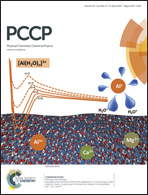The response of the electronic structure to electronic excitation and double bond torsion in fulvene: a combined QTAIM, stress tensor and MO perspective
Abstract
New insights into the double bond isomerization of fulvene in the ground and excited electronic states are provided by newly developed QTAIM and stress tensor tools. The S0 and S1 states follow the ‘biradical’ torsion model, but the double bond is stiffer in the S0 state; by contrast, the S2 state follows the ‘zwitterionic’ torsion. Differences are explained in terms of the ellipticity and bond critical point (BCP) stiffness for both QTAIM and the stress tensor. Overall, the wave-function based analysis is found to be in agreement with the work of Bonačić-Koutecký and Michl that the bond-twisted species can have biradical or zwitterionic character, depending on the state. Using QTAIM and the stress tensor a new understanding of bond torsion is revealed; the electronic charge density around the twisted bond is found not to rotate in concert with the nuclei of the rotated –CH2 methylene group. The ability to visualize how the bond stiffness varies between individual electronic states and how this correlates with the QTAIM and stress tensor bond stiffness is highlighted. In addition, the most and least preferred morphologies of bond-path torsion are visualized. Briefly we discuss the prospects for using this new QTAIM and stress tensor analysis for excited state chemistry.


 Please wait while we load your content...
Please wait while we load your content...